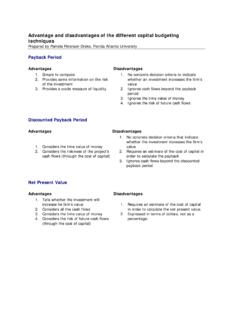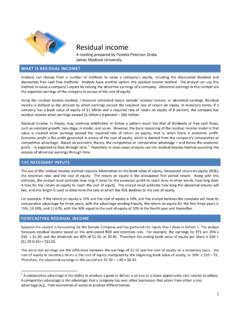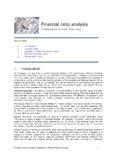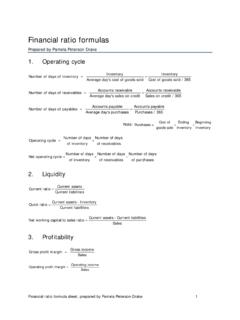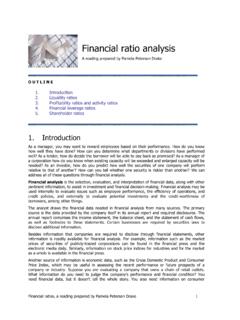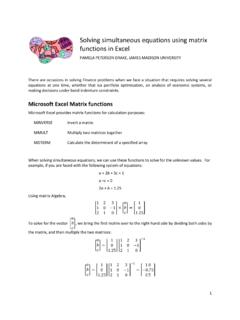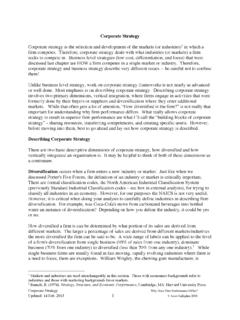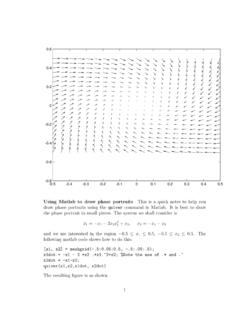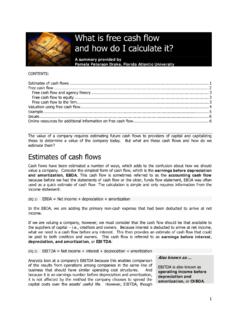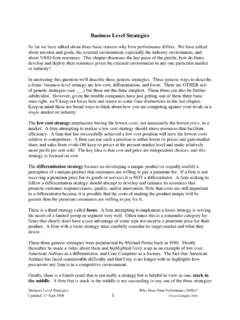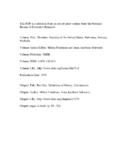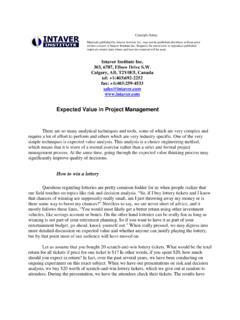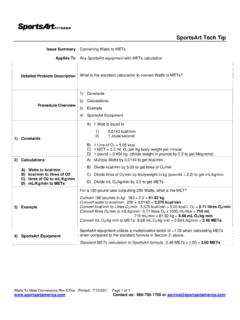Transcription of Solutions to Time Value of Money Practice Problems
1 Solutions to time Value of Money Practice Problems Prepared by Pamela Peterson Drake 1. What is the balance in an account at the end of 10 years if $2,500 is deposited today and the account earns 4% interest, compounded annually? quarterly? Annual compounding: FV = $2,500 (1 + )10 = $2,500 ( ) = $3, Quarterly compounding: FV = $2,500 (1 + )40 = $2,500 ( ) = $3, 2. If you deposit $10 in an account that pays 5% interest, compounded annually, how much will you have at the end of 10 years? 50 years? 100 years? 10 years: FV = $10 (1+ )10 = $10 ( ) = $ 50 years: FV = $10 (1 + )50 = $10 ( ) = $ 100 years: FV = $10 (1 + )100 = $10 ( ) = $1, 3.
2 How much interest on interest is earned in an account by the end of 5 years if $100,000 is deposited and interest is 4% per year, compounded continuously? Note: Interest on interest is the difference between the future Value calculated using compounded interest and the future Value calculated using simple interest, because simple interest includes only interest on the principal amount, not the interest-on-interest. Continuously compounded: FV = $100,000 (5) = $100,000 ( ) = $122, Simple interest: FV = $100,000 + [$100,000( )(5)] = $100,000 + 20,000 = $120,000 Interest on interest = $122, = $120,000 = $2, 4. How much will be in an account at the end of five years the amount deposited today is $10,000 and interest is 8% per year, compounded semi-annually?
3 FV = $10,000 (1+ )10 = $10,000 ( ) = $14, 5. Complete the following, solving for the present Value , PV: Case Future Value Interestrate Number ofperiods Present Value A $10,000 5% 5 $7, B $563,000 4% 20 $256, C $5,000 3 $4, 6. Suppose you want to have $ million saved by the time you reach age 30 and suppose that you are 20 years old today. If you can earn 5% on your funds, how much would you have to invest today to reach your goal? Solutions to time Value of Money Practice Problems 1 Given: FV = $500,000; i = 5%; n = 10 PV = $500,000 (1 / (1 + )10) = $500,000 ( ) = $306, 7.
4 How much would I have to deposit in an account today that pays 12% interest, compounded quarterly, so that I have a balance of $20,000 in the account at the end of 10 years? Given: FV = $20,000; i = 12%/4 = 3%; n = 10 x 4 = 40 quarters PV = $6, 8. Suppose I want to be able to withdraw $5,000 at the end of five years and withdraw $6,000 at the end of six years, leaving a zero balance in the account after the last withdrawal. If I can earn 5% on my balances, how much must I deposit today to satisfy my withdrawals needs? Given: Hint -- There are two different future values.
5 Treat as two separate present values, then combine. FV = $5,000; n = 5, i = 5% PV = $3, FV = $6,000; n = 6, i = 5% PV = $4, PV of the two future values = $3, + 4, = $8, Or, can use the NPV function in a financial calculator: In the TI-83/84, the cash flows are {0,0,0,0,5000,5000} In the HP10B, the cash flows are 0,0,0,0,0,5000,5000 9. Consider a loan of $1 million that is paid off quarterly over a period of nine years. Calculate the dollar amount of interest and loan principle repaid corresponding to each payment if the interest rate is 6% per year, compounded quarterly.
6 Year Quarter Beginning balance Payment Interest Principal repayment Remaining principal 0 $ 1,000, 1 $ 1,000, $ 36, $ 15, $ 21, $ 978, 2 $ 978, $ 36, $ 14, $ 21, $ 957, 3 $ 957, $ 36, $ 14, $ 21, $ 935, 1 4 $ 935, $ 36, $ 14, $ 22, $ 913, 5 $ 913, $ 36, $ 13, $ 22, $ 891, 6 $ 891, $ 36, $ 13, $ 22, $ 868, 7 $ 868, $ 36, $ 13, $ 23, $ 845, 2 8 $ 845, $ 36, $ 12, $ 23, $ 821, 9 $ 821, $ 36, $ 12, $ 23, $ 797, 10 $ 797, $ 36, $ 11, $ 24, $ 773, 11 $ 773, $ 36, $ 11, $ 24, $ 749, 3 12 $ 749, $ 36, $ 11, $ 24, $ 724, 13 $ 724, $ 36, $ 10, $ 25, $ 698, 14 $ 698, $ 36, $ 10, $ 25, $ 673, 15 $ 673, $ 36, $ 10, $ 26, $ 647, 4 16 $ 647, $ 36, $ 9, $ 26, $ 620, 17 $ 620, $ 36, $ 9, $ 26, $ 593, 18 $ 593, $ 36, $ 8, $ 27, $ 566, Solutions to time Value of Money Practice Problems 2 19 $ 566, $ 36, $ 8, $ 27, $ 538, 5 20 $ 538, $ 36, $ 8, $ 28, $ 510, 21 $ 510, $ 36, $ 7, $ 28, $ 482, 22 $ 482.
7 $ 36, $ 7, $ 28, $ 453, 23 $ 453, $ 36, $ 6, $ 29, $ 424, 6 24 $ 424, $ 36, $ 6, $ 29, $ 394, 25 $ 394, $ 36, $ 5, $ 30, $ 364, 26 $ 364, $ 36, $ 5, $ 30, $ 333, 27 $ 333, $ 36, $ 5, $ 31, $ 302, 7 28 $ 302, $ 36, $ 4, $ 31, $ 270, 29 $ 270, $ 36, $ 4, $ 32, $ 238, 30 $ 238, $ 36, $ 3, $ 32, $ 205, 31 $ 205, $ 36, $ 3, $ 33, $ 172, 8 32 $ 172, $ 36, $ 2, $ 33, $ 139, 33 $ 139, $ 36, $ 2, $ 34, $ 105, 34 $ 105, $ 36, $ 1, $ 34, $ 70, 35 $ 70, $ 36, $ 1, $ 35, $ 35, 9 36 $ 35, $ 36, $ $ 35, $ ( ) 10.
8 Suppose you deposit $100,000 in an account today that pays 6% interest, compounded annually. How long does it take before the balance in your account is $500,000? Given: I = 6%; PV = $100,000; FV = $500,000 Solution: N = 28 11. The Lucky Loan Company will lend you $10,000 today with terms that require you to pay off the loan in thirty-six monthly installments of $500 each. What is the effective annual rate of interest that the Lucky Loan Company is charging you? Given: PV = $10,000; N = 36; PMT = 500 Solve for i: i = EAR = (1 + )12 1 = 12. How long does it take for your Money to grow to ten times its original Value if the interest rate of 5% per year?
9 Given: PV = 1; FV = 10; I = 5% Solution: 48 years 13. Under what conditions does the effective annual rate of interest (EAR) differ from the annual percentage rate (APR)? If interest is compounded more frequently than once a year, the EAR will be different than the APR; the EAR will be greater than the APR except in the case in which there is annual compounding (in which case the EAR will be equal to the APR) 14. As the frequency of compounding increases within the annual period, what happens to the relation between the EAR and the APR? The EAR will become larger than the APR as the frequency of compounding increases.
10 The largest difference between the two is in the case in which interest is compounded continuously. 15. If interest is paid at a rate of 5% per year, compounded quarterly, what is the: a) annual percentage rate? Solutions to time Value of Money Practice Problems 3 APR = 5% b) effective annual rate? EAR = (1 + )4 - 1 = 16. L. Shark is willing to lend you $10,000 for three months. At the end of six months, L. Shark requires you to repay the $10,000, plus 50%. a) What is the length of the compounding period? Six months b) What is the rate of interest per compounding period? 50% c) What is the annual percentage rate associated with L.
